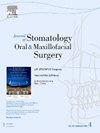Objectifying aesthetic outcomes following face transplantation – the AI research metrics model (CAARISMA ® ARMM)
IF 2
3区 医学
Q2 DENTISTRY, ORAL SURGERY & MEDICINE
Journal of Stomatology Oral and Maxillofacial Surgery
Pub Date : 2025-02-12
DOI:10.1016/j.jormas.2025.102277
引用次数: 0
Abstract
Background
Face transplantation (FT) offers a reconstructive option for patients with severe facial disfigurements by restoring both function and appearance. Aesthetic outcomes, which are crucial to psychological well-being and social reintegration, have historically been evaluated subjectively. This study introduces the AI Research Metrics Model (CAARISMA ® ARMM), a machine learning-based medical device designed to objectively assess aesthetic outcomes in FT patients.
Methods
Overall, 14 FT patients were analyzed using CAARISMA ® ARMM, which evaluates 3 key aesthetic indices: the Facial Youthfulness Index (FYI), Facial Aesthetic Index (FAI), and Skin Quality Index (SQI). Preoperative, postoperative, and pre-trauma images were processed to assess improvements in facial aesthetics. Statistical analysis was performed to compare changes in these indices across the different time points.
Results
Postoperative scores for FYI, FAI, and SQI were significantly higher than preoperative scores (p < 0.0001), indicating substantial aesthetic improvements. No significant differences were found between postoperative and pre-trauma images, suggesting that FT can effectively restore a patient's pre-injury appearance. Aesthetic improvements were consistent across different age and gender groups, with no notable disparities in outcomes.
Conclusion
CAARISMA ® ARMM offers a reliable and objective framework for objectifying aesthetic outcomes following FT, allowing for more standardized assessments. This medical device can potentially improve patient-surgeon communication, enhance surgical planning, and serve as a benchmark for evaluating long-term aesthetic success in FT patients. Future research should focus on expanding CAARISMA ® ARMM's application to larger and more diverse patient populations.
客观化面部移植后的美学结果-人工智能研究指标模型(CAARISMA®ARMM)
背景:面部移植(FT)通过恢复功能和外观为严重面部畸形患者提供了重建选择。审美结果对心理健康和社会重新融入至关重要,历史上一直是主观评价的。本研究介绍了人工智能研究指标模型(cararisma®ARMM),这是一种基于机器学习的医疗设备,旨在客观评估FT患者的美学结果。方法采用CAARISMA®ARMM对14例FT患者进行分析,评估3个关键美学指标:面部年轻指数(FYI)、面部美学指数(FAI)和皮肤质量指数(SQI)。术前、术后和创伤前的图像被处理以评估面部美学的改善。通过统计分析比较这些指标在不同时间点的变化。结果术后FYI、FAI、SQI评分均显著高于术前(p <;0.0001),表明美学上有了实质性的改进。术后与创伤前图像无明显差异,说明FT可以有效恢复患者损伤前的外观。不同年龄和性别群体的审美改善是一致的,结果没有显著差异。结论:cararisma®ARMM为FT后的美学结果客观化提供了可靠和客观的框架,允许更标准化的评估。这种医疗设备可以潜在地改善患者与外科医生的沟通,加强手术计划,并作为评估FT患者长期美学成功的基准。未来的研究应侧重于将cararisma®ARMM应用于更大、更多样化的患者群体。
本文章由计算机程序翻译,如有差异,请以英文原文为准。
求助全文
约1分钟内获得全文
求助全文
来源期刊

Journal of Stomatology Oral and Maxillofacial Surgery
Surgery, Dentistry, Oral Surgery and Medicine, Otorhinolaryngology and Facial Plastic Surgery
CiteScore
2.30
自引率
9.10%
发文量
0
审稿时长
23 days
 求助内容:
求助内容: 应助结果提醒方式:
应助结果提醒方式:


